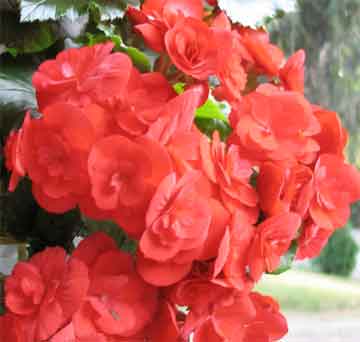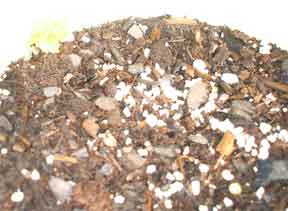Many landscape gardeners in the sizzling sections of Mid-America have ruefully concluded that tuberous begonias are something denied to them for outdoor garden decoration. Usually they have come to this conclusion after several summers of failure with these beauties.
Thank goodness, evidence is accumulating that we have been wrong. Apparently tuberous begonias CAN be grown even where the temperature at 100 and the dry winds blow out of the southwest for days on end. The secret, without doubt, is in keeping them cool.
Even in torrid atmospheres, there are some spots around every home that stay comparatively cool and moist. Carefully seek those locations and put your tuberous begonias there if you want to keep them through the summer.
If the right place is found for them, they will perform beautifully. With their vividly colorful flower they do much to brighten a dark corner where little else will bloom.

Where are these cool places? Every house has a northward side. Along this side the air will be cooler than anywhere else in the yard. If there are foundation windows on the north, where cool basement air drifts out, this place will be even cooler. If there is an outdoor faucet or air conditioner on the north where water drips or is spilled occasionally, this too will make the area nearby cool and agreeable for tuberous begonias.
They Need Light
Avoid placing these plants in extremely deep shade of trees or shrubbery for they need lots of indirect light. Many failures start with too much shade. In favored areas of the northern states we often find tuberous begonias basking in full sun at least part of the day but that would never do where summers are hot and dry. In selecting a site, bear in mind that by increasing the moisture and humidity to the plants, you can counteract to some extent a lack of coolness.
Last summer an ideal location was found for a test planting of tuberous begonias. By actual measurement the temperature there remained at an even 85 degrees while elsewhere in the yard it was over 100 in the shade. This spot was near a basement window on the north of the house. Drying winds parched the grass and other plants, but caused no serious damage to the tuberous begonias in their protected place. Hot sun never touched them, but there was plenty of light from the open sky.
Did they bloom through the heat? Indeed they did. The flowers probably dropped sooner than they would have in a cooler climate, but never through the summer was there a time when the plants were not in bloom. As the heat tempered a bit towards autumn, the plants took a fresh lease on life, and were ablaze with color in October when the first frost put an end to them.
How to Grow Them
Aside from temperature precautions, the culture of these flowers is the same in hot climates as it is elsewhere. Start the tubers indoors in March, in a box containing a mixture of moist peat moss and sand (two parts peat to one of sand). Do not cover them… just snuggle them down in the mixture. Add water around – not on them. Water standing in the hollow top side of a tuber may start rot.
The tubers will start well under fluorescent lights or in an east or north window where the temperature is above 60. In a short time the tubers will send up shoots which develop into husky stems and leaves, and a thick network of roots will form around the tuber. When the tops are three or four inches high, remove the plants from the starting mixture and pot them.
Use 6″ inch pots for average tubers. Make sure the pots drain well. Fill the pots with a soil rich mixture. Old timers would make their own consisting of equal parts peat moss (or leaf mold), sand and good garden loam, plus 1/4 part of dried cow manure, and bone meal at the rate of 1/4 cup to each six-inch pot full of mixture. The tuber should be only deep enough in the pot to be barely covered. It is well to put a small plant stake in the pot at the time of potting, for staking will probably be needed and it is difficult to insert a stake later without risk to the tuber or roots.
For Added Coolness

Keep the plants moderately moist, not wet, and they will grow along until time to put them outside. This should be done as soon as the weather becomes settled in the spring, and the frosts are over. Sink the pots up to the rims in the soil. For extra coolness and moisture protection, some avid begonia gardeners excavate an area for the pots and fill in beneath and around them with peat moss which is watered along with the plants.
This is a good method for growing them above ground level in planters or window boxes. Moisture evaporating from this packing of course adds coolness and humidity to the atmosphere, much to the liking of the plants.
Tuberous begonias also grow well planted directly in the ground if the soil has been lightened and enriched. But they are not so easy to handle as when in pots, either at setting out time in spring, or at lifting time in fall.
A feeding of liquid plant food every three weeks through the summer will keep them in full bloom. Pests do not seem to be very bothersome on tuberous begonias. For a safeguard, handle them with the same all-purpose spray you may use on the roses, lilies and other flowers in your landscape. To keep slugs and snails from disfiguring the leaves, put a few bait pellets around the base of the plants.
